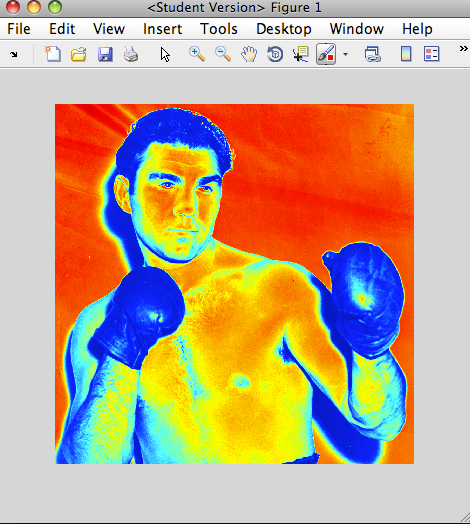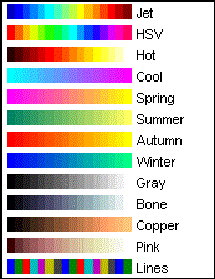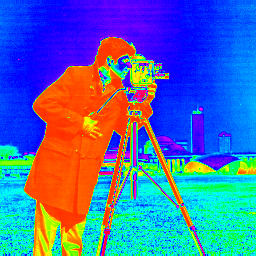change grayscale to pseudo colouring using colormap in Matlab
change grayscale to pseudo colouring using colormap in Matlab
In matlab you can view a grayscale image with:
imshow(im)Which for my image im shows:
And you can also view this grayscale image using pseudocolors from a given colormap with something like:
imshow(im,'Colormap',jet(255))Which shows:
But it’s not obvious how to use the colormap to actually retrieve the RGB values we see in the plot. Here’s a simple way to convert a grayscale image to a red, green, blue color image using a given colormap:
rgb = ind2rgb(gray2ind(im,255),jet(255));Replace the 255 with the number of colors in your grayscale image. If you don’t know the number of colors in your grayscale image you can easily find out with:
n = size(unique(reshape(im,size(im,1)*size(im,2),size(im,3))),1);It’s a little overly complicated to handle if im is already a RGB image.
If you don’t mind if the rgb image comes out as a uint8 rather than double you can use the following which is an order of magnitude faster:
rgb = label2rgb(gray2ind(im,255),jet(255));Then with your colormaped image stored in rgb you can do anything you normally would with a rgb color image, like view it:
imshow(rgb);which shows the same as above:
Possible function names include real2rgb, gray2rgb.
Tags: color, grayscale, image processing, matlab
What you are asking is to perform a pseudo colouring of an image. Doing this in MATLAB is actually quite easy. You can use the grayscale intensities as an index into a colour map, and each intensity would generate a unique colour. First, what you need to do is create a colour map that is 256 elements long, then use ind2rgb to create your colour image given the grayscale intensities / indices of your image.
There are many different colour maps that are available to you in MATLAB. Here are the current available colour maps in MATLAB without the recently added Parula colour map that was introduced in R2014:

How the colour maps work is that lower indices / grayscale values have colours that move toward the left side of the spectrum and higher indices / grayscale values have colours that move toward the right side of the spectrum.
If you want to create a colour map with 256 elements, you simply use any one of those colour maps as a function and specify 256 as the input parameter to generate a 256 element colour map for you. For example, if you wanted to use the HSV colour map, you would do this in MATLAB:
cmap = hsv(256);Now, given your grayscale image in your MATLAB workspace is stored in imageArray, simply use ind2rgb this way:
colourArray = ind2rgb(double(imageArray)+1, cmap);The first argument is the grayscale image you want to pseudocolour, and the second input is the colour map produced by any one of MATLAB's colour mapping functions. colourArray will contain your pseudo coloured image. Take note that we offset the grayscale image by 1 and also cast to double. The reason for this is because MATLAB is a 1-indexed programming language, so we have to start indexing into arrays / matrices starting at 1. Because your intensities range from [0,255], and we want to use this to index into the colour map, we must make this go from [1,256] to allow the indexing. In addition, you are most likely using uint8 images, and so adding 1 to a uint8 will simply saturate any values that are already at 255 to 255. We won't be able to go to 256. Therefore, you need to cast the image temporarily to double so that we can increase the precision of the image and then add 1 to allow the image to go to 256 if merited.
Here's an example using the cameraman.tif image that's part of the image processing toolbox. This is what it looks like:

So we can load in that image in MATLAB like so:
imageArray = imread('cameraman.tif');Next, we can use the above image, generate a HSV colour map then pseudocolour the image:
cmap = hsv(256);
colourArray = ind2rgb(imageArray+1, cmap);We get:

Take note that you don't have to use any of the colour maps that MATLAB provides. In fact, you can create your own colour map. All you have to do is create a 256 x 3 matrix where each column denotes the proportion of red (first column), green (second column) and blue (third column) values per intensity. Therefore, the first row gives you the colour that is mapped to intensity 0, the second row gives you the colour that is mapped to intensity 1 and so on. Also, you need to make sure that the intensities are floating-point and range from [0,1]. For example, these are the first 10 rows of the HSV colour map generated above:
>> cmap(1:10,:)
ans =1.0000 0 01.0000 0.0234 01.0000 0.0469 01.0000 0.0703 01.0000 0.0938 01.0000 0.1172 01.0000 0.1406 01.0000 0.1641 01.0000 0.1875 01.0000 0.2109 0You can then use this custom colour map into ind2rgb to pseudocolour your image.
Good luck and have fun!
change grayscale to pseudo colouring using colormap in Matlab的更多相关文章
- colormap是MATLAB里面用来设定和获取当前色图的函数。
下面将举例.描述MATLAB内建的色图.用户除了可以编程指定MATLAB内建的色图,还可以使用Plot Tools图形用具界面的Figure Properties面板中的Colormap菜单来选择一种 ...
- How to Change the Size of a Box-Plot Label in MATLAB
Type "load carsmall" to load a sample data set included with MATLAB. Type "boxplot(Ho ...
- 利用matlab编写实现显示fmri切片slice图像 混合显示 不同侧面显示 可叠加t检验图显示 by DR. Rajeev Raizada
1.参考 reference 1. tutorial主页:http://www.bcs.rochester.edu/people/raizada/fmri-matlab.htm. 2.speech_b ...
- linux安装Tesseract-OCR
安装Tesseract-OCR 1. leptonica 需要源码编译安装http://www.leptonica.org/ leptonica 包: leptonica-1.73.tar.gz 解 ...
- 【论文速读】Fangfang Wang_CVPR2018_Geometry-Aware Scene Text Detection With Instance Transformation Network
Han Hu--[ICCV2017]WordSup_Exploiting Word Annotations for Character based Text Detection 作者和代码 caffe ...
- matlab学习笔记9 高级绘图命令_2 图形的高级控制_视点控制和图形旋转_色图和颜色映像_光照和着色
一起来学matlab-matlab学习笔记9 高级绘图命令_2 图形的高级控制_视点控制和图形旋转_色图和颜色映像_光照和着色 觉得有用的话,欢迎一起讨论相互学习~Follow Me 参考书籍 < ...
- matplotlib绘制热力图
版权声明:本文为博主原创文章,遵循 CC 4.0 by-sa 版权协议,转载请附上原文出处链接和本声明.本文链接:https://blog.csdn.net/jin_tmac/article/deta ...
- 利用Matlab快速绘制栅格地图
代码演示 % 基于栅格地图的机器人路径规划算法 % 第1节:利用Matlab快速绘制栅格地图 clc clear close all %% 构建颜色MAP图 cmap = [1 1 1; ... % ...
- V-rep学习笔记:机器人逆运动学数值解法(The Pseudo Inverse Method)
There are two ways of using the Jacobian matrix to solve kinematics. One is to use the transpose of ...
随机推荐
- python之守护进程
主进程创建子进程,然后将该进程设置成守护自己的进程,守护进程就好比崇祯皇帝身边的老太监,崇祯皇帝已死老太监就跟着殉葬了. 关于守护进程需要强调两点: 其一:守护进程会在主进程代码执行结束后就终止 其二 ...
- centos 7 查看所有登录用户的操作历史
2019-01-07 转自 https://www.cnblogs.com/kevingrace/p/7373146.html centos 7 查看所有登录用户的操作历史 在Linux系统的环境下 ...
- c# Equals方法
很多C#的教材都会强调对象相等的概念.我们都知道,在C#的世界里存在两种等同性.一种是逻辑等同性:如果两个对象在逻辑上代表同样的值,则称他们具有逻辑等同性.另一种是引用等同性:如果两个引用指向同一个对 ...
- 通过view实现字段的只读、隐藏操作【转】
原文地址:http://cn.openerp.cn/view_groups/ 在OpenERP V7视图(ir.ui.view)多了一个非常有用的字段(groups_id) 'groups_id': ...
- (转)mysql 备份与恢复mysqlhotcopy
原文:http://fuwenchao.blog.51cto.com/6008712/1331910 mysqlhotcopy是一个Perl脚本,最初由Tim Bunce编写并提供.它使用LOCK T ...
- android中画弧函数canvas.drawArc()之理解
在学习android中图形图像处理技术这部分内容时,对绘制圆弧函数canvas.drawArc()的用法.参数含义及画图原理很是不理解,在网上搜索了一些,加上自己的理解,在此做个小总结,作为学习过程中 ...
- Python案例之QQ空间自动登录程序实现
不多说,直接上干货! 工具选择: 电脑系统:win7,32 位,下面第二部安装SetupTools时注意系统版本要求: Python: 2.7.11, 相信只要是2.7的就可以实现: Seleniu ...
- C 扩展库 - sqlite3 API CRUD
CRUD struct student typedef struct STUDENT { unsigned int id; unsigned char name[16]; unsigned int a ...
- PHP之string
string addcslashes() Quote string with slashes in a C style 以 C 语言风格使用反斜线转义字符串中的字符 addslashes() Quot ...
- CentOS/Linux 解决 SSH 连接慢
现在连接linux服务器一般都是使用SSH远程连接的方式.最近新装了一台服务器,发现telnet时速度很快,ping时一切也正常,但SSH连接的时候却很慢.经过网上资料查询,大致是有以下几种原因: 1 ...
